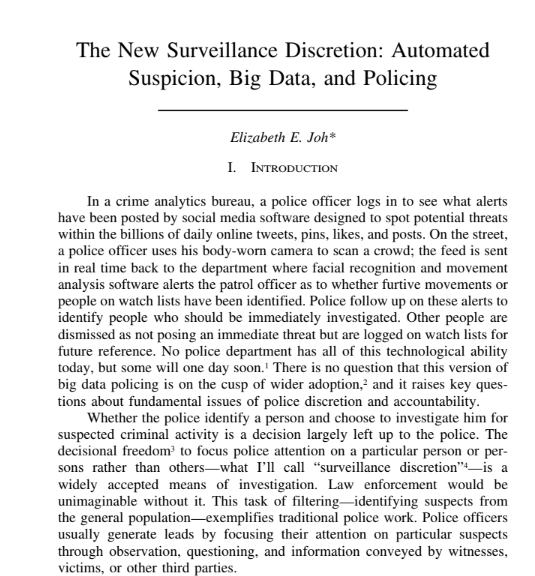The New Surveillance Discretion: Automated Suspicion, Big Data, and Policing by Elizabeth E. Joh

| Title | The New Surveillance Discretion: Automated Suspicion, Big Data, and Policing by Elizabeth E. Joh |
| Author | Elizabeth E. Joh About Elizabeth Joh Professor Joh is a renowned authority on policing, privacy, and technology. She was part of the U.C. Presidential Working Group on Artificial Intelligence (2020-21) and holds membership in the American Law Institute. Additionally, she serves on the Faculty Advisory Board of the U.C. Berkeley CITRIS Policy Lab and is a member of the National Academies of Sciences, Engineering, and Medicine committee studying facial recognition’s capabilities, future prospects, and governance. She has delivered talks on policing and technology to prominent audiences, including the Justices of the Washington Supreme Court, the Supreme Court of Korea’s Judicial Research Training Institute, and the House of Lords Justice and Home Affairs Committee in the U.K. Her academic work has been published in prestigious law reviews such as the Northwestern University Law Review, the California Law Review, and the Stanford Law Review. For broader audiences, her writings have appeared in publications like the New York Times, the Los Angeles Times, Slate, Politico, and the New York Review of Books. She also co-hosts the podcast What Roman Mars Can Learn About Con Law, which focuses on constitutional law and current events. |
| Overview | Overview of “The New Surveillance Discretion: Automated Suspicion, Big Data, and Policing” by Elizabeth E. Joh Elizabeth E. Joh’s article, “The New Surveillance Discretion: Automated Suspicion, Big Data, and Policing,” explores the profound implications of emerging technologies on police surveillance and discretion. Joh examines how advances in big data, automated analytics, and surveillance technologies are reshaping traditional practices in law enforcement, raising critical concerns about police accountability and civil liberties. Joh begins by illustrating the current and future capabilities of surveillance technologies in policing. She describes scenarios where police use sophisticated tools like body-worn cameras, facial recognition software, and social media monitoring systems to detect and evaluate potential threats. These technologies enable law enforcement to process vast amounts of data—from online posts to real-time video feeds—at unprecedented speeds, allowing for the identification of suspicious activities and individuals. The article emphasizes that the use of these technologies represents a significant shift from traditional policing methods. Historically, police discretion involved human judgment in investigating leads and targeting suspects based on limited information. With the advent of big data, however, the scope of surveillance has expanded dramatically. Law enforcement agencies can now analyze extensive datasets to uncover patterns and predict criminal activity, potentially transforming how suspects are identified and investigated. Joh discusses the concept of “surveillance discretion,” which refers to the latitude police have in choosing whom to investigate based on available data. Traditionally, this discretion was constrained by practical limitations such as resource availability and the need for tangible leads. In contrast, modern technologies lower these constraints, enabling police to conduct large-scale surveillance and analyze vast quantities of data. This shift raises significant questions about how discretion is exercised and the potential for misuse or overreach. The expansion of surveillance capabilities brings about new challenges for police oversight. Joh highlights that while the Fourth Amendment traditionally governs specific investigative actions like arrests and searches, it has limited application to the preliminary decision-making process of identifying potential suspects. The article notes that the Supreme Court’s decisions generally do not regulate how police select individuals for surveillance before any formal action is taken. This lack of oversight raises concerns about how much unchecked power police might have in monitoring and investigating individuals based solely on automated data analysis. Joh contrasts the current state of surveillance discretion with historical practices. She notes that while previous methods of investigation were constrained by resource limitations and human judgment, new technologies enable police to monitor and analyze more data than ever before. This shift challenges existing legal frameworks, as the traditional standards for probable cause and reasonable suspicion may not adequately address the realities of big data policing. The article also touches on the legal and policy implications of these advancements. Joh points out that while courts have debated whether certain uses of technology require a warrant or probable cause, such as the collection of historical cell site data, many issues remain unresolved. The article suggests that the rapid development of surveillance technologies outpaces the ability of legal standards to adapt, leading to a gap in protections for individuals’ privacy rights. In conclusion, Joh’s article underscores the need for a reassessment of legal and policy frameworks to address the challenges posed by modern surveillance technologies. As big data and automated analytics become increasingly integral to policing, ensuring robust oversight and accountability mechanisms will be crucial in safeguarding civil liberties and maintaining public trust in law enforcement practices. |
| Download Link | click here to download |